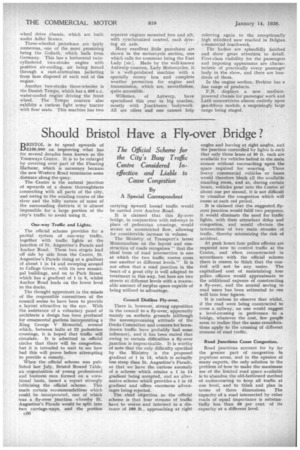Should Bristol Have a Fly-over Bridge ?
Page 28

If you've noticed an error in this article please click here to report it so we can fix it.
The Official • Scheme for the City's Busy Traffic Centre Considered Ineffective and Liable to • Cause Congestion
By A Special Correspondent
rikRISTOL is to spend upwards of LI£100,000 on improving what has for several decades been known as the Tramways Centre. It is to be enlarged by covering over part of the Floating Harbour, which is necessary because the new Western Road terminates sorne distance along the quay. • The Centre is the natural junction of upwards of a dozen thoroughfares connecting with all parts of the city, and owing to the winding course of the river and the hilly nature of some of the surrounding districts it is almost impossible for a large portion of the city's traffic to avoid using it, One-way Traffic and Lights.
• The official scheme provides for a partial system of one-way traffic, together with traffic lights at the junction of St. Augustine's Parade and Anchor Road. These two streets lead of side by side from the Centre, St. Augustine's Parade rising at a gradient of about 1 in 14 and sweeping around to College Green, with its new municipal buildings, and on to Park Street, which has a gradient of 1 in 9, whilst Anchor Road leads on the lower level to the docks.
The thought uppermost in the minds of the responsible committees of the council seems to have been to provide a layout attractive to the eye. With the assistance of a voluntary panel of architects a design has been produced for ornamental gardens incorporating a King George V Memorial, around which, between halts at 22 pedestrian crossings, it is hoped that traffic will circulate. It is admitted in official circles that there will be congestion, but it is intended to wait to see how bad this will prove before attempting to provide a remedy.
When the official scheme was published last July, Bristol Round Table, an organization Of young professional and business men formed on a vocational basis, issued a report strongly 'criticising the official scheme. This made certain recommendations which could be incorporated, one of which was a fly-over junction whereby St. Augustine's Parade would be split into two carriage-ways, and the portion of10 carrying upward bound traffic would be carried over Anchor Road.
It is claimed that this fly-over bridge, in conjunction with subways in place of pedestrian crossings, would secure an unrestricted flow, allowing for considerable increase in volume.
The Ministry of Transport's latest Memorandum on the layout and construction of roads recognizes " that the ideal form of road intersection is one at which the two traffic routes cross one another at different levels." It is not often that a road junction in the heart of a great city is well adapted to treatment in this way, but here are two streets at different levels with a reasonable amount Of surplus space capable of being utilized to advantage.
Council Dislikes Ply-over.
There is, however, strong opposition in the council to a fly-over, apparently mainly on wsthetic grounds (although the uncompromising attitude of the Docks Committee and concern for horsedrawn traffic have probably had some influence), and it has been stated that owing to certain difficulties a fly-over junction is impracticable. It is worthy of note that the only difficulty specified by the Ministry is the proposed gradient of 1 in 15, which is actually less steep than St. Augustine's Parade, so that we have the curious anomaly of a scheme which retains a 1 in 14 gradient being accepted, and an alternative scheme which provides a 1 in 15 gradient and offers enormous advantages being rejected.
The chief ob•jection to the official scheme is that four streams of traffic have to weave and intersect in a distance of 100 ft., approaching at right
angles and leaving at right angles, and the junction•controlled by lights is such that only three lanes of SO ft. each are available for vehicles halted in the main stream without encroaching upon the space required for weaving. . Three heavy c.ommercial. vehicles or .buses would therefore block all the available standing room, and as, during certain hours, vehicles. pour into the Centre at about one per second, it is not difficult to visualize the congestion which will ensue at each red period. •
It is claimed that the suggested, flyover junction would fulfil two purposes; it would eliminate the need for traffic lights, with their attendant delay and congestion, and would obviate the intersection of two main streams of traffic, thereby minimizing the risk of accident, At peak hours four police officers are required now to control traffic at the Centre, and when reconstructed in accordance with the official scheme there is reason to think that the control will not be any easier. 'The capitalized cost of maintaining four police officers would approximate to the additional expense of constructing a fly-over, and the annual saving to road users has been estimated to run well into four figures.
It is curious to observe that whilst, if the road were being constructed to cross a railway, DO one would suggest a level-crossing in preference to a bridge, whatever the cost, few people seem to realize that the same considerations apply to the crossing of different streams of road traffic.
Road Junctions Cause Congestion.
Road junctions account for by far the greater part of congestion'In populous areas, and in the opinion of many experts, the only solution to the problem of how to make the maximum use of the limited road space available is to abandon the old-fashioned method of endeavouring to keep all traffic at one level, and to think and plan in terms of three dimensions. The capacity of a road intersected by other roads of equal importance is substantially less than 50 per cent. of its capacity at a different level.


































